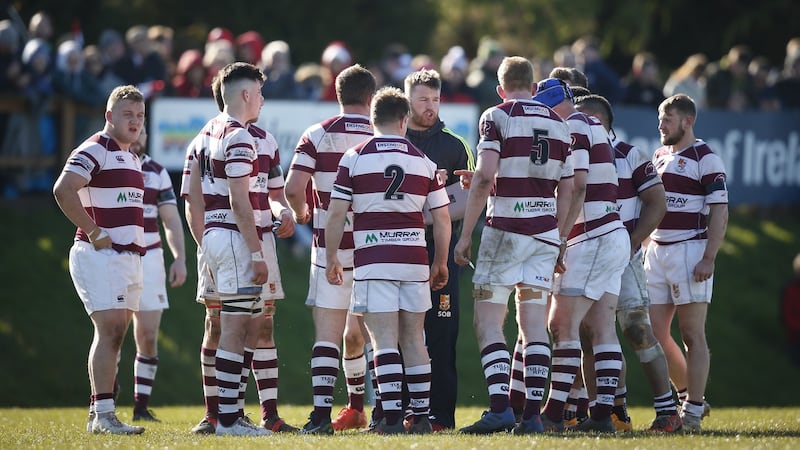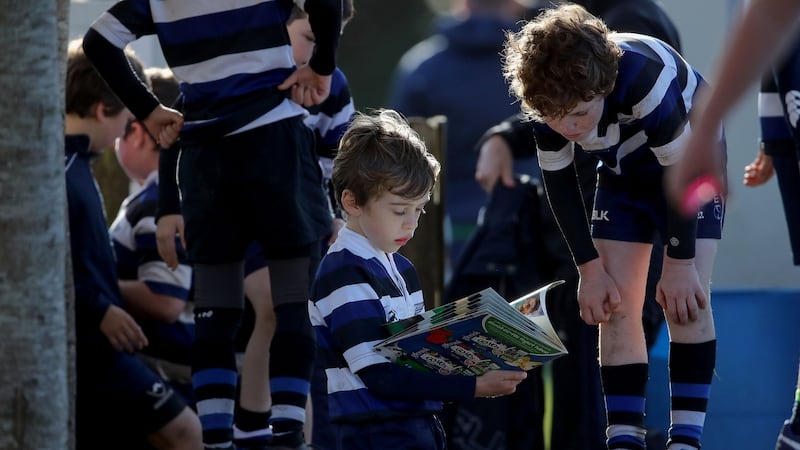For the professional game the multi-million financial losses will be much more severe, whenever rugby returns and in whatever guise. But, while these things are relative, the mere millions lost at amateur level will be felt just as acutely, if not more, and the longer this hiatus lasts the greater the likelihood of an irreversible drop in playing numbers and also the increasing probability of clubs going to the wall.
Club rugby is no different from their counterparts in other team sports, but whereas the professional game can potentially mass test, provide full-time medical attention and even cocoon their players and staff, the amateur game cannot do so.
What’s more, club players live with families and friends, mingle in the community and, if they’re lucky, still have jobs. They’ll be the last to return, and this includes all of women’s rugby. Never before has the pro and amateur games seemed so two-tiered.
Overseeing all of the club game at the best of times is equivalent to being handed the Minister for Health portfolio in Government.
Colin McEntee has done as much as anyone to help identify and nurture talent through the famed Leinster system before moving on to the IRFU; firstly as high-performance manager and then elite player development. He took over the role of director of rugby development in 2019, effectively overseeing the domestic game.
A former number 8 with Lansdowne and Leinster, he believes passionately in the club game. But if not before, with the coronavirus pandemic his role certainly looks like the poisoned chalice.
“Everybody who participates in the game, be it a volunteer or a playing member, the club game is the constant, isn’t it? You have a defined period in the schools game of five years, the constant is the club. A lot of players will go club to school, and then back to club, and it’s the connection to the community as well, and that’s the connection back to the pro game as well. It has to be hand in glove as opposed to being separated.”
There are 50 senior clubs, 10 more separate women’s clubs and then adding in all the junior clubs, there are a total of 217 rugby clubs in Ireland.
Starting with the Energia All-Ireland League clubs, the first hit has been financial. “We’re talking six figures-plus,” says Paul Cunningham, president of Old Belvedere. “Probably €100,000 in income would be the average. Certainly of the clubs I’ve spoken to, and that would be at least half a dozen clubs in Leinster.
“Your club would be rented out with various events for the summer. I know there were concerts planed in certain clubs. The Horse Show is a big loss for us, and Wanderers the same. We had various social events, exams and what not.”

Many other clubs had to cancel their annual dinners, added to which would be birthday parties, underage summer camps, tag rugby etc.
The likely cost of running a Division 1A club is at least €500,000, possibly more, and while income has dried up, costs haven’t.
“There’s staff [albeit offset by the Governments revenue support scheme], insurance, rates, loans, cleaning – your basic costs still have to be met,” says Cunningham. “You have to keep it in working order. Many have kept on ground staff so that they’re ready to go when clubs are allowed to reopen.”
Nor is it just the IRFU who will miss out on an estimated €5 to €10 million in gate receipts should the November Tests be played behind closed doors and, worse still, circa €15million were the Six Nations to be similarly afflicted.
Tests at the Aviva are another lifeblood to the clubs. Whether as paybacks to sponsors or corporate packages, some Dublin clubs could be missing out on up to €70,000 per match, with other clubs in Limerick, Cork, Connacht and Ulster perhaps making up to €30-40,000 per Irish home game.
Viewed in this light, the IRFU’s hardship fund of €500,000 for 217 clubs looks inadequate, and only 65 to 70 have applied for assistance.
“I think there’s mixed messages out there saying that Scotland or Wales or England have done something different. No they haven’t,” says McEntee a little indignantly. “The Welsh gave €1,000 to each club, pro rata. Scotland did exactly the same as ourselves and the RFU provided loans.
“We understand our clubs are struggling and we’ll support them as best we can. It would be our hope that we had 217 clubs going into this, you’d love to have 217 clubs coming out. That’s utopia.”
There are roughly 194,000 registered players in Ireland, of which the schools game is the biggest bulk supplier, with 20,000 mini rugby players and 20,000 are adult players.
Cunningham’s biggest concern is how many players will, or will not, continue playing. “Obviously there is a health issue, above all else. This is a killer disease, and that’s the bottom line.
“The potential for people to give up the game is a serious one. I fear you may find a lot of players won’t go back playing at all. And it’s not men in their late 20s or 30s. It’s underage rugby, women’s rugby. And I don’t have the answers. No one has the answers, until the health and safety come through with a solution.”
Clubs are usually an integral part of their local communities in ways that provinces cannot be and are often inextricably linked. For example, Corinthians’ main sponsor for the last 25 years is that celebrated Galway pub, Busker Brownes, which is owned by the Clifden proprietor Terry Sweeney.
For clubs like Corinthians, the summer off-season is a key time.
Brian Casburn, head of Corinthians finance committee, says: “We have the biggest tag event in the country, 80 teams [1600 players] who are there [Corinthian Park] every Thursday night for 10 weeks.”
Corinthians also have their facilities hired for sport and leisure activities by local businesses, as well as summer rugby camps, six-a-side football and so on.
The club had also bought 12 acres to add to the existing 11.5 acres at Corinthian Park with a view to installing another Astroturf pitch and more facilities, as well as pitches. This is to supplement the existing three pitches and an Astroturf, which are in constant use and require €20-25,000 maintenance every year.
So, how much has this hiatus cost the club so far?
“You’re talking about €180,000 to €200,000,” says Casburn, which accounts for half of the €370-€380,000 to run the club annually.
“Luckily, we don’t have any debt,” admits Casburn. “It’s going to put us back a year or two because all the youths are looking for more pitches as they get flooded during the winter. But my hope remains that in eight to 10 years we’re going to have a savage club.”

Corinthians have 340 mini players, and ditto their youths section, as well as 100 senior players and 80 non-playing members, in putting out 15 or 16 teams most weekends.
If there was a delayed return into the new year, Casburn fears another significant loss financially and in playing numbers, for all clubs in Connacht, as he lists off Galwegians, Ballina, Loughrea, Tuam, Monivea, Connemara, Sligo and Creggs.
“Most of them will be hit worse than us, and we need them all. It’s going to be extremely hard, especially in the west, and we’re all competing with other sports. I mean, if the GAA came back before rugby, they’d pull a lot of players in. Nothing against the GAA. We have a lot of guys involved in GAA in all sections of our club, but that would kill us.”
The timing of this pandemic was no less cruel on junior clubs, For example, the prestigious Provincial Towns Cup was abandoned after one round.
Tullow RFC had contracted SIS Pitches to start installing a 3G pitch.
“They moved in on March 26th, and moved out on the 27th,” says Paddy Browne, chairman of the club. SIS returned to work on May 18th, and helpfully the good weather has facilitated removing top soil. Tullow are also turning around their main pitch which, allied to the acquisition of more land, will enable them to create a third pitch in addition to the two they’ve long had.
“We’re spending around €600,000 thanks to a generous grant from Leader [a rural funding initiative], or it wouldn’t have worked otherwise,” admits Browne, and all of this work should be completed in eight weeks.
“We had a dream, and it was only a dream at this stage, of opening the new pitches with a match between Leinster and London Irish, given Seán’s move from Leinster to London Irish,” says Browne, in reference to their most celebrated son, Seán O’Brien, and the notion of a pre-season friendly.
An annual golf classic has been cancelled, and all told Browne reckons Tullow have lost €20-€30,000 since the beginning of the lockdown – a significant hole in the annual costs of €150,000 in running the club.
However, the real damage would be if the hiatus continued into the new year and beyond, and the club potentially losing €15,000 in membership fees. “That’s our biggest fear because we want to keep paying our coaches and physios.”
As it is, Tullow have a vibrant underage section, with over 200 mini players, a similar number of youths, 60 adults (including a women’s team) and 60-70 non-playing members/volunteers.
“Realistically, we wouldn’t regain the ground we’d lose in terms of membership fees and a series of fundraisers,” admits Browne. “About four or five of those are held between September and Christmas.
“It’s an amateur game and we’ve a lot of farmers in the club. Trying to get them to play regularly can be a big ask and players teetering on the brink of retiring it might push them to make a decision that they mightn’t have made otherwise.”
Yet McEntee maintains there are what he calls “green shoots”.
“I think the roadmap set out by the Government gives us that light, all going well, through the phases to pre-phase five,” says McEntee in reference to the August 10th date for the resumption of close physical contact sports such as rugby and boxing.
By contrast, competitions in teams sports (‘for example, soccer and GAA’) can resume in stage four, July 20th, and sports “behind closed doors” can do so in stage three, June 29th.
“I think we shouldn’t be separated from other team sports,” says McEntee. “We have different formats in terms of pre-contact that can overlap with what other sports are doing in, say, stage four or even stage three.”
He sees other green shoots in the imminent return of rugby at both community and professional level in New Zealand, where training has resumed and matches will return from June 13th.
The IRFU have just completed a survey, which all 10 women’s clubs and 50 men’s clubs responded to, and which they are in the middle of assessing.
Concerns remain about travel restrictions, as well as safety, and there is a willingness among clubs to resume playing on a regional/provincial basis as a stepping stone toward an AIL, with an understanding that the format might be altered for one season.
The likely best-case scenario therefore is some localised competitions to begin with, as either a precursor to a shortened AIL in the second half of the 2020-21, or with the AIL resuming in 2021-22.
“The priority for us is just to get people playing, get our clubs back open again. Do it phases but get that connection back would be massive,” says McEntee. “The game is bigger than us all.”
Never a truer word.




















